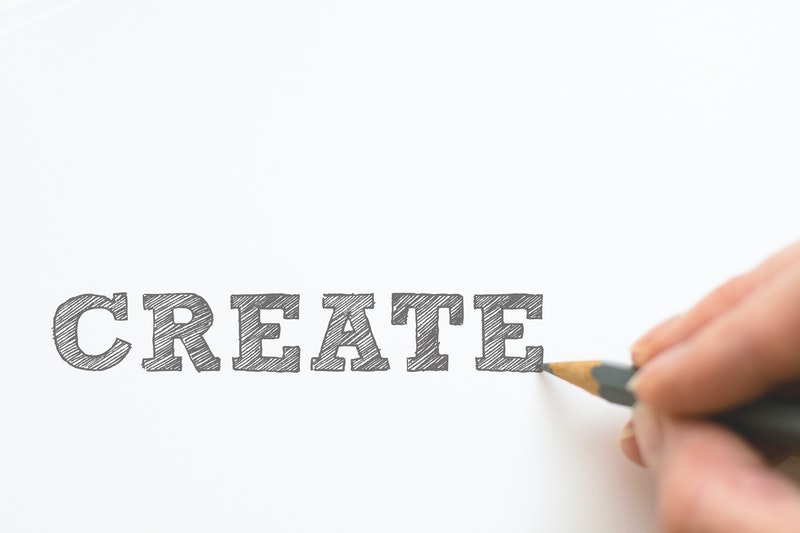So there I was, sitting here trying to write an article on how to fall asleep, and no matter what I did, my attention kept going anywhere but where I wanted it to be. Faced with writers’ block, what I needed was a way to explode my creativity. I figured others might have this problem too, so here’s what I did to fix it.
When we don’t appreciate exactly how our creative minds work, it’s quite easy to find ourselves getting stuck. And when we do, it can feel like we’re doing everything but what we tell ourselves we should be doing. The key to getting around this is to have a simple step-by-step process that we can follow, specifically designed to work the way our minds want to. In this article, I’ll cover what creativity is, exactly how to be more creative, and I’ll give you a simple process anyone can follow to effortlessly overcome procrastination and writers’ block.
And who wouldn’t want to know how to beat procrastination and writers’ block with a simple step-by-step process that anyone can follow?
What is Creativity and Where Does It Come From
Creativity. You know how it goes, right? Perhaps you’re wanting to write something. Or maybe you want to design a new product or process. It could even be that you work in one of the most creative fields there is, such as physics or mathematics. Creativity happens all around us all the time in every field of human endeavor.
Most of us even think we know what creativity is. You can go up to just about any person in the street and ask them about it, and they’ll give you some opinions. But if you ask them how creativity works, or even for a concrete definition, they suddenly become a lot more vague, or just don’t know.
So you sit down to be creative and try to come up with something new. And nothing happens. It’s even worse than that, because over time you notice that it’s precisely the things that you know the most about, that is, your areas of actual expertise, where we find ourselves having the least creativity.
Naturally this can tend to be quite annoying, since it’s usually in our areas of expertise that we can most easily make the biggest contribution to progress.
The reason that this happens is to do with exactly how our brains go about processing information on the level of neural connections. And the good news is that once we know exactly what’s going on, it’s quite easy to design and implement a process to overcome writers’ block, procrastination, or whatever the equivalent might be in your own field of creative inquiry, so that you can effortlessly become more creative and, hopefully, never get stuck again.
Now I invite you to take that last statement with a tiny grain of salt. After all, didn’t I just write that I spent yesterday stuck with the exact thing I’m writing about now? I’m so glad you noticed! Yes, yes I did! The thing is, even when we know the solution, we do still have to implement it.
When I was stuck for most of yesterday, I knew how to fix the problem, because I’d done so many times before. I just didn’t remember to do it. This happens sometimes.
What is true though is that once you know how to fix the problem of writers’ block or a lack of creativity, all you have to do is remember to follow the process, and then follow it.
So how do we go about doing that?
Well it begins with a definition of creativity. What does it mean to be creative?
When we look at the way our brains are structured, it very quickly becomes apparent that there isn’t really anything internal that can cause significant amounts of creativity other than our memories of things that we’ve experienced.
Creativity happens when we combine two or more things together in a new or novel way.
Creativity happens when we combine two or more things together in a new or novel way.
That’s literally all there is to it. Now, I’m not suggesting here that this is good or useful creativity. Just that it is the core of the process. Due to the phenomenon of emergence, in reality we need multiple layers and the combination of a number of things for the outcome to be something that most of us would consider to be creative.
But it’s important to understand that core process, because understanding exactly what’s going on is the key to exploding our creativity on every level.
How the Creative Process Works
Now that we know that the source of all creativity is nothing more than the combination of two or more things in new and novel ways, it starts to become much clearer how we go about usefully creating it.
So to begin, the lightning overview.
If we want to be more creative in our endeavors, the overall process looks something like first, become an expert in something. Then, look into other fields and notice what patterns underlie what’s going on there. As we’re doing this, ask ourselves how what we’re doing might apply to our original field. Next, go back to the original field and let it go enough that we can begin to make useful changes to it. Finally, apply those patterns to the thing we’re expert in, and notice what happens.
Naturally this is an iterative process that we loop through many times.
When we do this, we tend to either end up with something brilliant, a new understanding, or total nonsense. And because we’re the expert, usually we’ll know how to tell the three apart.
And it’s important to note that even when we end up with total nonsense, this is often useful in itself. When we don’t have a base of both expertise and nonsense to draw on, it’s much more difficult for us to spot either.
Now when you look through the process outlined above, it probably all makes sense. And you’re probably thinking something like How exactly do I let go? And how do I know what’s the right amount?
The way we do this comes down to where we place our attention.
You see, the way our minds work is largely through association. And a consequence of this is that stuff tends to be grouped with other stuff like it inside our minds. Ultimately this leads to huge aggregations of information structures inside our minds.
For example, inside my mind there are undoubtedly large aggregations around personal development, hypnosis and psychology in general, physics and mathematics, and a handful of other areas where I’ve dedicated the time and resources to grow my expertise. Each of these fields is largely independent, but also massively interlinked.
Your mind will be just the same, only oriented around your own fields of expertise.
This structure of grouping information that way has a consequence. When we’re fully focused in on the thing we’re expert at, it’s quite hard to step outside of that. So if we want to let go, what we need to do is deliberately place our attention somewhere else. It can be anywhere else at all, although some destinations for our attention are less effective than others.
Now, since we can improve our creativity by pulling in patterns from other fields, it follows that if we want to get good at it, we need to build that skill. We want to be able to build bridges between the different fields of knowledge inside our minds. This will allow us to utilize the knowledge in other fields. The way we can do this is by developing a habit of being curious about how what we’re doing at any point in time might apply to the other things we do throughout our lives.
To get good at being creative, we want to build bridges between the different fields of knowledge inside our minds.
A few years back I was building and experimenting with neural networks in an effort to construct a data analysis engine. As I was doing that, I noticed some interesting patterns starting to form, and I automatically asked myself how they could apply to hypnosis, physics and emergence in general.
In doing so I made some useful realizations in all three fields. I won’t go into these in any depth here, because that’s not what this article is about. For hypnosis though, It led to me forming an understanding of how information has to be encoded inside a neural network for it to work. Then, being a scientist, I went out and tested it to verify that it applied to actual human beings. After a bit of testing, I concluded that yes, it does. And in fact it’s the basis of this article that you’re reading right now.
This underlying reason is exactly the same thing that makes it hard for us to recall happy memories when we’re sad, it is the same thing that leads to agreement frames and yes sets, and it’s even the same thing that leads to mathematicians rarely making great discoveries after the age of 30 or so.
How to Cause Creativity
Now that we’ve got all the pieces in place, we’re in a good place to start to design a process for causing creativity to happen on demand.
It may sound counter-intuitive, but the very first thing we need to do is to set a goal. That is, we want to have something that we’re going to achieve. In this example, I’ll use writing a blog post, and the technique applies to every other field of human endeavor just as well. I’d follow the same process if I wanted to design a new propulsion system for a spacecraft, if I wanted to build a new piece of software, or if I wanted to demonstrate that the big bang theory is likely to be nonsense.
Set a goal and get your brain moving.
Depending on the size of the goal, you may want to also figure out exactly why that goal is important to you so that you can keep on doing the things necessary to achieve it. With a smaller goal, this is less necessary since it takes less time to complete smaller tasks.
In the case of this article that you’re reading right now, my goal is to help you to subtly change the way you choose to do things so that you can increase your creativity. Beyond this, it adds value to the world, since it’s something that has the potential to help a lot of people and to supercharge their creative processes.
For some of us, if we want to have a hope of completing our goal, we next need to take some simple steps to defeat procrastination. There are a lot of ways to do this, but for now, I’ll give you a simple technique that has worked for me.
A lot of the time the cause of procrastination is that either we don’t know what to do, or we doubt whether we can actually do it. In setting our goal, we’ve already overcome the first. To overcome the second, we need to appreciate something about how our brains work.
You see, our brains are organized in such a way that they like to optimize work. If something seems too hard and we can’t immediately get a real sense of what it will be like when we’ve achieved the goal, we are highly likely to not do it.
So the solution is simple. In order to overcome procrastination once we’ve set our goal, first close your eyes for a few moments and imagine that you’ve already achieved that goal. Then look around inside your mind and notice what’s different. Pay particular attention to what it feels like. This is the key. If we want to achieve our goals, it’s important to be motivated towards them, and one of the easiest ways to do this is to become fully in touch with the emotional benefits of reaching those goals. And these can be anything at all. The only thing that matters is that they are important to you.
Once you’ve got a goal in mind, and you know exactly what it will be like to have reached your goal, next up we want to kick-start our brain. This part is what makes the difference between our goal being a dream and becoming a reality.
To kick-start our brain, we need to understand a little about how brains work. As I mentioned earlier, it’s quite easy to think that something is too hard even when we intellectually know that it is well within our abilities. The way to work around this is that we have to go back just a little to something that is so easy for us we wouldn’t even consider that we can’t do it.
Back when I was studying to become a physicist, this is how I got through countless math exercises and studied for exams. I knew that the thing had to be done, so if I had any trouble getting started at all, I would simply pick some random exercises from the previous year and do those. Since these were very easy for me by that point, it got my brain going, and usually within 20 minutes or so I’d be ready to move on to the new stuff.
To get started on something when you’re stuck, spend a few moments working on a task that you can easily do in the same general field.
Since then I have discovered that this process applies to just about anything you can imagine. The key is to get your brain moving. Our thoughts have inertia, and once our thoughts are moving it becomes easier to just keep right on working, even on the harder tasks.
Next up, we may need to do some research. Depending on what your task is, you may already be an expert and have all the necessary knowledge. Or you may have to spend any amount of time from minutes to years doing research.
The important key at this step is that if you’re going to be creative, you really need to be the expert first so that you have the ability to determine whether what you’re doing is useful or not.
Become an expert in the area where you want to be creative. You probably already are, so this step is mostly for completeness.
Now, in reality, most of the time we will already be the expert in the field of our choosing. In our modern society, we’re already experts at a large number of things by the time we reach high school.
If you doubt this, just compare a typical high school kid from today with the most educated people from 1000 years ago, and you’ll quickly see that a lot of the stuff we think of as being obvious and something that everyone knows is actually the result of millions of years of research and experimentation by large numbers of people throughout history, each building on the work of their predecessors.
For this article, my research was started long ago. And is also constantly ongoing.
If you are totally stuck for ideas, at this point you want to do something else completely. It can be anything at all. And as you’re doing that new thing, occasionally ask yourself how it might relate to your area of expertise. When we develop this into a habit, creativity starts to become effortless.
After we’ve done the research and then done something different for a bit, and we’ve got a good map of it inside our heads, the next step is creating a mind map.
To do this, grab a sheet of paper and a pen, and write one word in the middle of the sheet of paper. For this article, the word is Creativity.
Then, get rid of all distractions and write ideas out as fast as you can.
Don’t filter them at all. Just write whatever comes into your head, placing it where it seems sensible on the sheet of paper.
Be sure to write down everything that comes into your head, even if it doesn’t seem to apply.
When I was working through this process for this article, after writing the word creativity, the very next thing I wrote was Other fields with a circle around it and a line linking it directly to the word Creativity.
How much you do this depends on exactly what you’re working on and what your goal happens to be.
Once you’ve got the mind map, go through it looking for any words that don’t seem to fit. Figure out where that word came from, and imagine doing that thing. Then when you’ve got a clear picture of that in your mind, ask yourself how what you’re doing might apply to your goal.
Pull in ideas from other fields and ask yourself how they might apply to the area where you want to be more creative.
As an example, the mind map for this article has the expression Neural networks written on it. This is a reference to the time I was developing neural networks
So the questions I asked myself were how does what I’ve learnt from my experiments with neural networks relate to creativity, and how can I apply any discoveries from those experiments to better understand the creative process. The answer to those questions forms the basis for this article.
Finally, we want to assess whether what we’ve come up with actually makes sense. You’re the expert, so only you know how to do this part.
Then repeat.
7 Easy Steps to Explode Your Creativity Now
So that’s really all there is to it. Creativity is not a mystical process that happens by accident. It is something that we can cause to happen on demand by following a simple process.
- Set a goal and get ourselves moving towards that goal.
- Become an expert in the area where we want to be creative.
- Develop the habit of asking yourself how things apply to your area of expertise as you explore other fields.
- Write out a map on a sheet of paper around the specific area where we want to explode our creativity.
- Ask ourselves questions about the relationships between the different things on the map and use this to be creative in the original area.
- We’re the expert, so take a few moments to check whether the result of our creativity actually makes sense. In software development, we usually refer to this as a sanity check. Your own field of expertise will have something similar, so use whatever is appropriate for your field.
- Loop back to the beginning.
Naturally, when we set goals, we tend to be quite keen on actually achieving them.
If you’d like to know more about how to create a well-formed goal, and then achieve that goal, you might enjoy reading my article on How to Get Results next.




